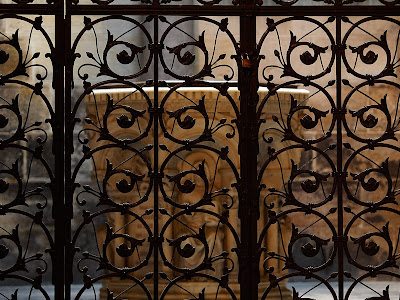Lk 1:39-45
The days are moving fast, like the cinematic device of pages dropping off a calendar so as to show the rapid passing of time. Tonight we will already pray the third of the seven "O Antiphons"
O Radix Jesse,
qui stas in signum populorum . . .
"O Root of Jesse,
you have been raised up as a sign for all peoples;
kings stand silent in your presence;
nations bow down in worship before you.
Come, let nothing keep you from coming to our aid.
The tone of the readings is shifting to one of barely contained joy as they recall that the promises of old were fulfilled: "from you shall come forth one who is to be ruler in Israel; whose origin is from of old, from ancient times." We heard Jesus' genealogy two days ago. That long list of sometimes difficult names is a reminder that He, who was present before the beginning of time, entered, fully God and fully man, into time and space. Soon we will recall and celebrate that Jesus, Son of God and Son of Mary, was born into this same earth on which we walk, work and relax, pray and struggle, like us in all things but sin. Today's gospel, Mary's visitation to Elizabeth is singled out for meditation as one of the joyful mysteries in the rosary, as well as a contemplation in the Spiritual Exercises of St Ignatius.
Ignatian contemplation engages one's full imagination with a short passage from the Gospel to focus the contemplation. Each exercise involves preparatory steps or preludes followed by three points for meditation.
The first prelude for the Visitation calls for meditation on the overall narrative. Mary has been told that she is to be the Mother of Our Lord. She hastens to visit Elizabeth. She is probably still taken aback by the angel's message. Nonetheless, she sets out on the 90-mile journey to the hill country of Judah.
The second prelude considers the place and the setting for the narrative. Today's gospel supplies few details, thus allowing one's imagination free rein. Imagine the travel from Bethlehem to the Hill Country. Was the road smooth or rocky, wide or narrow? How steep were the hills? What was Mary carrying with her? How was she dressed? (I suspect she was not dressed in blue watered silk with seed pearls and rhinestones.) It is certain that she made the five or six day journey in caravan with others and not alone. And then she arrived at her destination.
What did Elizabeth's home look like? Was it large or small? Were there many windows? How was it furnished? Is the atmosphere hot or cold, dry or damp? Were there aromas of cooking food?
Enter the scene as if you were stepping from your seat in a theater into the action on a stage or screen. Once the scene has been composed in as much detail as you would like or need move on to the three points for meditation.
First: when Elizabeth heard Mary's greeting, John leapt in her womb, and Elizabeth replied, "Blessed art thou among women and blessed is the fruit of thy womb."
The second meditation is Mary's Magnificat,
Magnificat anima mea Dominum;
Et exultavit spiritus meus in Deo salutari meo,
"My soul proclaims the greatness of the Lord,
My spirit rejoices in God my savior"
The third meditation considers Mary remaining with Elizabeth for three months before making her 90-mile return journey. During my two long retreats, the first in winter 1998 at Gloucester, MA as a novice and thirteen years afterwards as a tertian in Australia, this meditation was all-consuming, perhaps because it is so human and thus easy to identify with. Many questions on this third point consumed my attention.
Both women were first time mothers; one was young and the other somewhat older. Both pregnancies were unexpected. Both pregnancies were miraculous, each in its own way. What did they talk about over their three months together? How did they sound? Besides the usual daily tasks, how did they occupy their time?
Trappist priest, poet, and writer Thomas Merton described this exquisite mystery in his reflection on the contemplative vocation titled: "The Quickening of John the Baptist" that reads in part:
"The day Our Lady, full of Christ,
Entered the dooryard of her relative
Did not her steps, light steps,
lay on the paving leaves like gold?
Did not her eyes as grey as doves
Alight like the peace of a new world
upon that house, upon miraculous Elizabeth?
Her salutation
Sings in the stone valley like a Charterhouse bell:
And the unborn saint John
Wakes in his mother’s body,
Bounds with the echoes of discovery."
Tomorrow we will move one step closer to the celebration of the Great Feast of the Nativity of Our Lord as we pray the fourth of the O Antiphons.
O Clavis David
veni, et educ vinctum de domo carceris,
sedentem in tenebris,
et umbra mortis.
O Key of David, . . .
come, break down the prison walls of death
for those who dwell in darkness and the shadow of death.
_______________________________________
Photos from St. Martin d'Ainay in Lyon, France. One of the oldest churches in Lyon it was part of an 8th century Benedictine Abbey.
 |
| There was some sort of ceremony happening while I was there. The chandelier in magnificent. |
 |
| The iron work on the baptistry gate in extraordinary. |
 |
| Window overlooking the organ. The colors of the glass were very intense. |
 |
| Altar to Mary. |
 |
| Europen churches have chairs rather than pews. |
 |
| The Organ |
Off to the Abbey of Regina Laudis to celebrate the Christmas liturgies from 23 to 27 December.
+Fr. Jack, SJ, MD
No comments:
Post a Comment